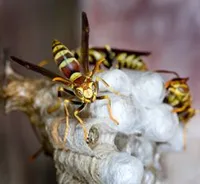In the fall wasps and bees become sluggish and easier for our pets to sometimes find. They are more 
Multiple stings are dangerous. Most of the time, an insect sting is just painful and irritating. Getting stung several times, or stung inside the mouth or throat, is dangerous and requires a trip to the veterinarian.
Bee and wasp stings are poisons. It’s not the small puncture wound that causes the sting's pain, but the small amount of poison that is injected.
- A bee’s stinger is barbed and designed to lodge in the skin, killing the bee when the stinger detaches from the body
- Wasp stingers are not barbed but are more painful, and if provoked these insects can sting multiple times
Most of the time pets get stung on their faces or feet from investigating a stinging insect too closely. A sting the sensitive nose is particularly painful. Some animals may even get stung on the tongue or inside their mouth or throat if they try to bite or catch an insect. These stings can be dangerous. The subsequent swelling can close an animal’s throat and block the airway.
Watch for allergic reactions. A severe reaction can be caused by a large number of stings or by an allergic reaction.
Signs of a reaction include:
- General weakness
- Difficulty breathing
- A large amount of swelling extending away from the sting site
If your dog is having a severe reaction, you need to take the dog to a vet immediately.
A simple sting can be safely left alone. It should be bothersome only temporarily. If a stinger is still present, try to remove it by scraping it with a fingernail or a rigid piece of cardboard. Avoid using tweezers or forceps to remove it unless absolutely necessary as this may force more venom out of the stinger.
Administer a remedy for the pain. Applying a weak mixture of water and baking soda to the affected area will help reduce the pain. You can also wrap ice or an icepack in a towel and apply it to the wound to reduce swelling and pain.
Never administer oral medication without checking with your veterinarian first. Some pain medication can be toxic to pets.
Maintain a watchful eye on your dog. Observe your dog closely after the sting incident to ensure an allergic reaction doesn’t develop. If several days pass and the swelling does not go down, notify your veterinarian.
Adapted from Hill’s Pet "How to Handle Dog's Wasp or Bee Sting"
